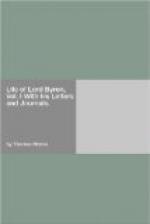[Footnote 7: The priory of Newstead had been founded and dedicated to God and the Virgin, by Henry II.; and its monks, who were canons regular of the order of St. Augustine, appear to have been peculiarly the objects of royal favour, no less in spiritual than in temporal concerns. During the lifetime of the fifth Lord Byron, there was found in the lake at Newstead,—where it is supposed to have been thrown for concealment by the monks,—a large brass eagle, in the body of which, on its being sent to be cleaned, was discovered a secret aperture, concealing within it a number of old legal papers connected with the rights and privileges of the foundation. At the sale of the old lord’s effects in 1776-7, this eagle, together with three candelabra, found at the same time, was purchased by a watch-maker of Nottingham (by whom the concealed manuscripts were discovered), and having from his hands passed into those of Sir Richard Kaye, a prebendary of Southwell, forms at present a very remarkable ornament of the cathedral of that place. A curious document, said to have been among those found in the eagle, is now in the possession of Colonel Wildman, containing a grant of full pardon from Henry V. of every possible crime (and there is a tolerably long catalogue enumerated) which the monks might have committed previous to the 8th of December preceding:—“Murdris, per ipsos post decimum nonum diem Novembris, ultimo praeteritum perpetratis, si quae fuerint, exceptis.”]
[Footnote 8: The Earl of Shrewsbury.]
[Footnote 9: Afterwards Admiral.]
[Footnote 10: The following particulars respecting the amount of Mrs. Byron’s fortune before marriage, and its rapid disappearance afterwards, are, I have every reason to think, from the authentic source to which I am indebted for them, strictly correct:—
“At the time of the marriage, Miss Gordon was possessed of about 3000 l. in money, two shares of the Aberdeen Banking Company, the estates of Gight and Monkshill, and the superiority of two salmon fishings on Dee. Soon after the arrival of Mr. and Mrs. Byron Gordon in Scotland, it appeared that Mr. Byron had involved himself very deeply in debt, and his creditors commenced legal proceedings for the recovery of their money. The cash in hand was soon paid away,—the bank shares were disposed of at 600 l. (now worth 5000 l.)—timber on the estate was cut down and sold to the amount of 1500_l._—the farm of Monkshill and superiority of the fishings, affording a freehold qualification, were disposed of at 480_l._; and, in addition to these sales, within a year after the marriage, 8000_l._ was borrowed upon a mortgage on the estate, granted by Mrs. Byron Gordon to the person who lent the money.




